Financial Management Report: Ratio Analysis for Business Review
VerifiedAdded on 2023/06/11
|13
|2424
|451
Report
AI Summary
This report provides a comprehensive overview of financial management, emphasizing its importance in planning, controlling, and optimizing resource allocation within a business. It delves into key financial statements such as the income statement, balance sheet, and cash flow statement, explaining the use of ratios in assessing profitability, liquidity, and efficiency. The report includes a completed business review template and an income statement and balance sheet created in Excel, based on a case study. Through ratio analysis, the report evaluates the company's financial performance, highlighting areas for improvement, such as marketing strategies and cost management. The analysis includes gross profit margin, net profit margin, asset turnover ratio, stock turnover ratio, and liquidity ratios. The conclusion underscores the role of financial management in achieving economic stability and increasing revenue and net earnings.

Financial management
Paraphrase This Document
Need a fresh take? Get an instant paraphrase of this document with our AI Paraphraser
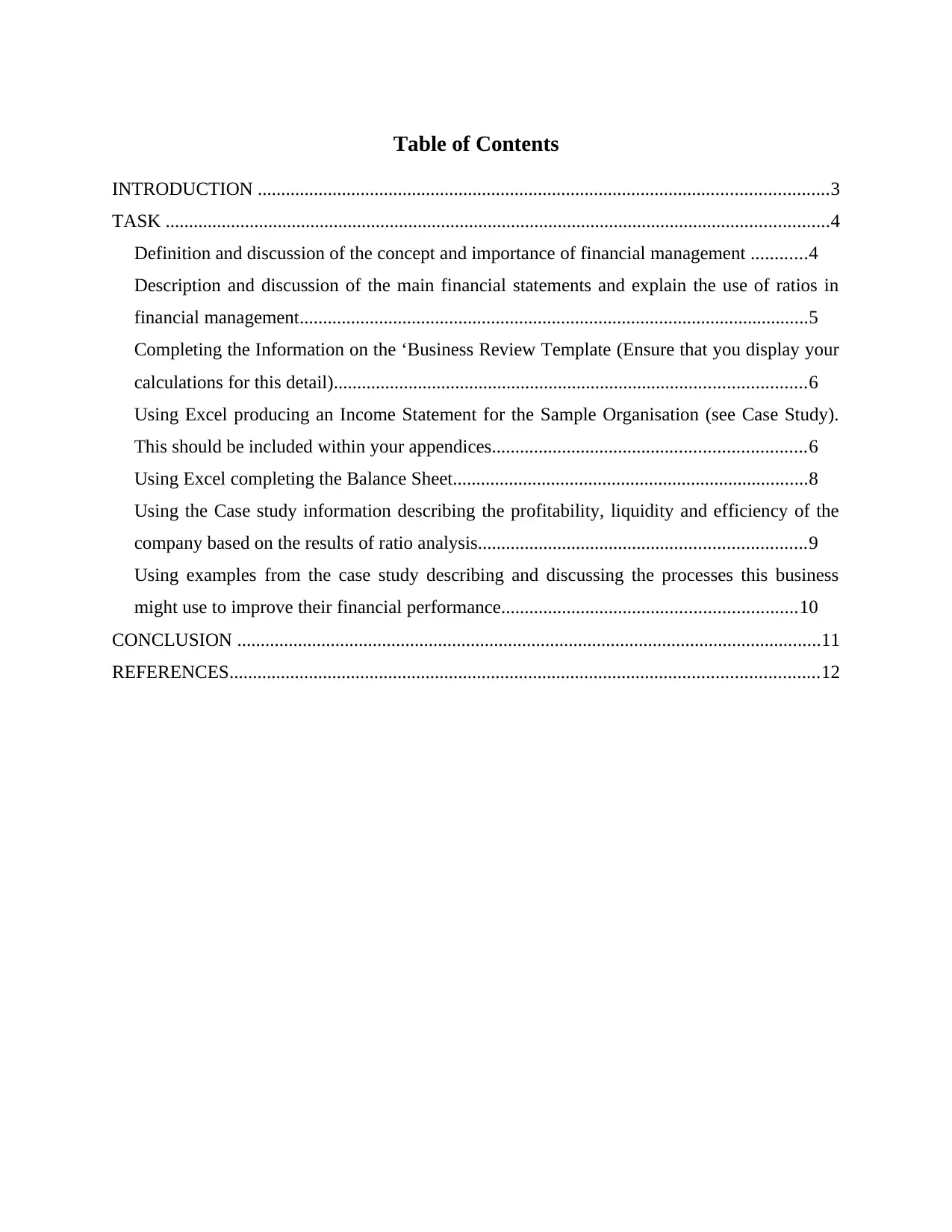
Table of Contents
INTRODUCTION ..........................................................................................................................3
TASK ..............................................................................................................................................4
Definition and discussion of the concept and importance of financial management ............4
Description and discussion of the main financial statements and explain the use of ratios in
financial management.............................................................................................................5
Completing the Information on the ‘Business Review Template (Ensure that you display your
calculations for this detail).....................................................................................................6
Using Excel producing an Income Statement for the Sample Organisation (see Case Study).
This should be included within your appendices...................................................................6
Using Excel completing the Balance Sheet............................................................................8
Using the Case study information describing the profitability, liquidity and efficiency of the
company based on the results of ratio analysis......................................................................9
Using examples from the case study describing and discussing the processes this business
might use to improve their financial performance...............................................................10
CONCLUSION .............................................................................................................................11
REFERENCES..............................................................................................................................12
INTRODUCTION ..........................................................................................................................3
TASK ..............................................................................................................................................4
Definition and discussion of the concept and importance of financial management ............4
Description and discussion of the main financial statements and explain the use of ratios in
financial management.............................................................................................................5
Completing the Information on the ‘Business Review Template (Ensure that you display your
calculations for this detail).....................................................................................................6
Using Excel producing an Income Statement for the Sample Organisation (see Case Study).
This should be included within your appendices...................................................................6
Using Excel completing the Balance Sheet............................................................................8
Using the Case study information describing the profitability, liquidity and efficiency of the
company based on the results of ratio analysis......................................................................9
Using examples from the case study describing and discussing the processes this business
might use to improve their financial performance...............................................................10
CONCLUSION .............................................................................................................................11
REFERENCES..............................................................................................................................12
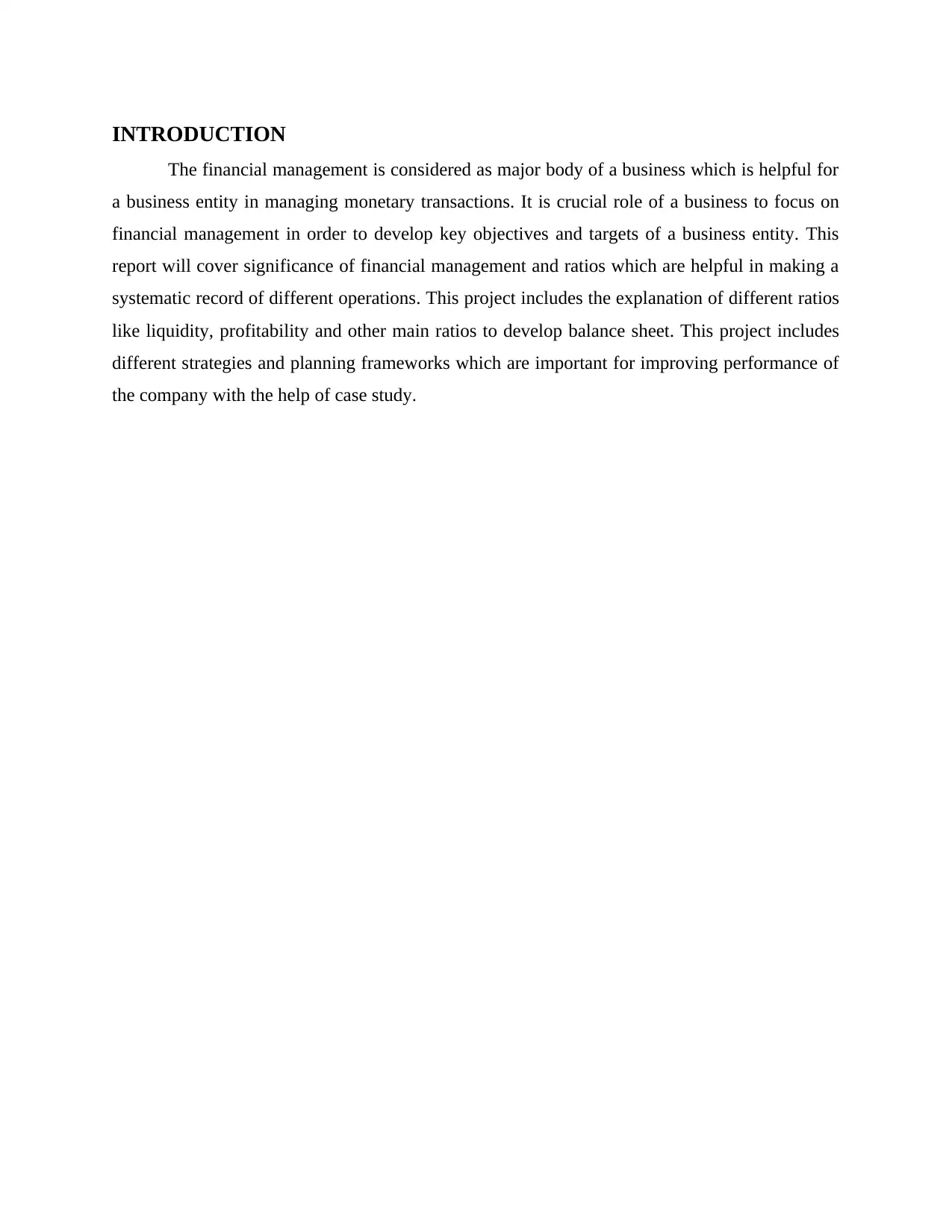
INTRODUCTION
The financial management is considered as major body of a business which is helpful for
a business entity in managing monetary transactions. It is crucial role of a business to focus on
financial management in order to develop key objectives and targets of a business entity. This
report will cover significance of financial management and ratios which are helpful in making a
systematic record of different operations. This project includes the explanation of different ratios
like liquidity, profitability and other main ratios to develop balance sheet. This project includes
different strategies and planning frameworks which are important for improving performance of
the company with the help of case study.
The financial management is considered as major body of a business which is helpful for
a business entity in managing monetary transactions. It is crucial role of a business to focus on
financial management in order to develop key objectives and targets of a business entity. This
report will cover significance of financial management and ratios which are helpful in making a
systematic record of different operations. This project includes the explanation of different ratios
like liquidity, profitability and other main ratios to develop balance sheet. This project includes
different strategies and planning frameworks which are important for improving performance of
the company with the help of case study.
⊘ This is a preview!⊘
Do you want full access?
Subscribe today to unlock all pages.

Trusted by 1+ million students worldwide
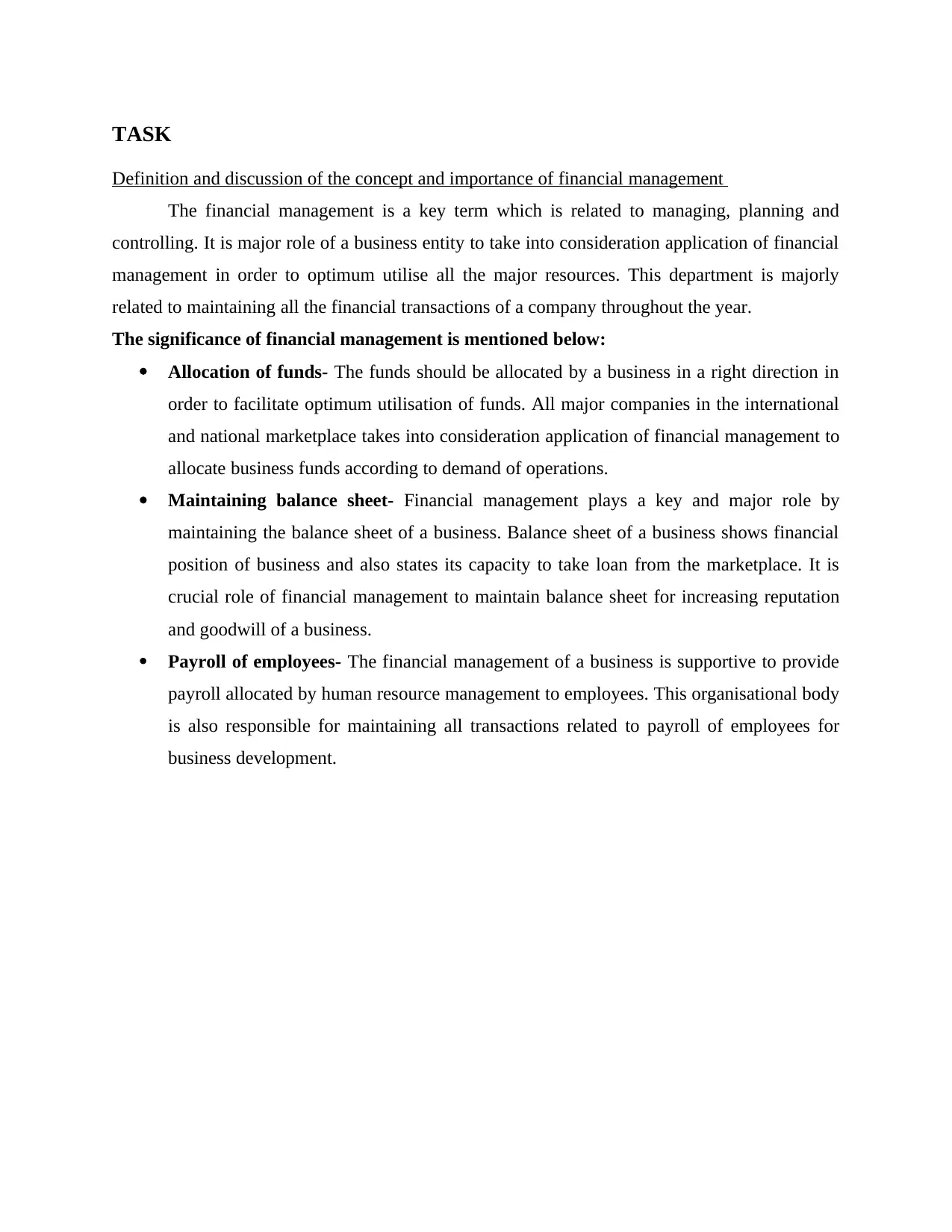
TASK
Definition and discussion of the concept and importance of financial management
The financial management is a key term which is related to managing, planning and
controlling. It is major role of a business entity to take into consideration application of financial
management in order to optimum utilise all the major resources. This department is majorly
related to maintaining all the financial transactions of a company throughout the year.
The significance of financial management is mentioned below:
Allocation of funds- The funds should be allocated by a business in a right direction in
order to facilitate optimum utilisation of funds. All major companies in the international
and national marketplace takes into consideration application of financial management to
allocate business funds according to demand of operations.
Maintaining balance sheet- Financial management plays a key and major role by
maintaining the balance sheet of a business. Balance sheet of a business shows financial
position of business and also states its capacity to take loan from the marketplace. It is
crucial role of financial management to maintain balance sheet for increasing reputation
and goodwill of a business.
Payroll of employees- The financial management of a business is supportive to provide
payroll allocated by human resource management to employees. This organisational body
is also responsible for maintaining all transactions related to payroll of employees for
business development.
Definition and discussion of the concept and importance of financial management
The financial management is a key term which is related to managing, planning and
controlling. It is major role of a business entity to take into consideration application of financial
management in order to optimum utilise all the major resources. This department is majorly
related to maintaining all the financial transactions of a company throughout the year.
The significance of financial management is mentioned below:
Allocation of funds- The funds should be allocated by a business in a right direction in
order to facilitate optimum utilisation of funds. All major companies in the international
and national marketplace takes into consideration application of financial management to
allocate business funds according to demand of operations.
Maintaining balance sheet- Financial management plays a key and major role by
maintaining the balance sheet of a business. Balance sheet of a business shows financial
position of business and also states its capacity to take loan from the marketplace. It is
crucial role of financial management to maintain balance sheet for increasing reputation
and goodwill of a business.
Payroll of employees- The financial management of a business is supportive to provide
payroll allocated by human resource management to employees. This organisational body
is also responsible for maintaining all transactions related to payroll of employees for
business development.
Paraphrase This Document
Need a fresh take? Get an instant paraphrase of this document with our AI Paraphraser
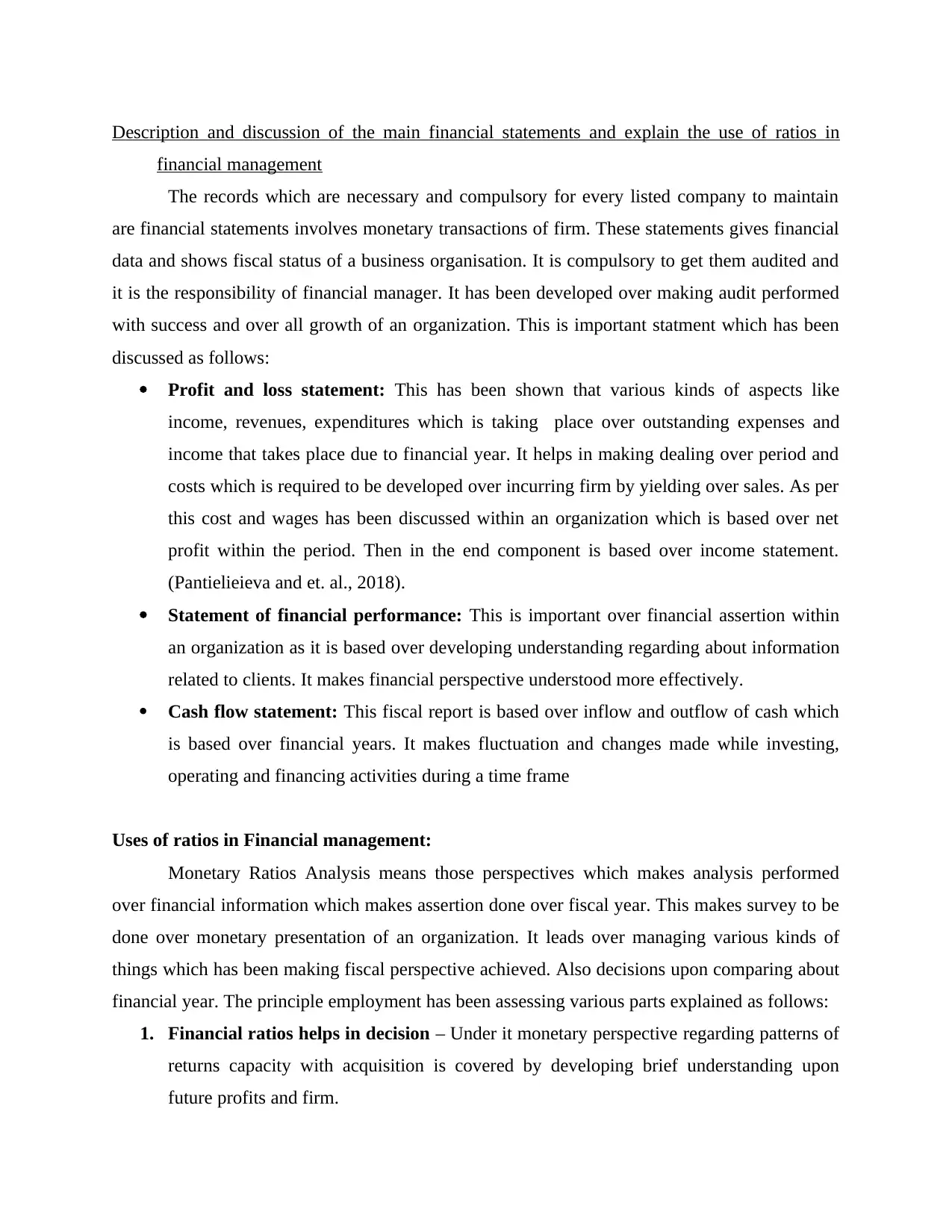
Description and discussion of the main financial statements and explain the use of ratios in
financial management
The records which are necessary and compulsory for every listed company to maintain
are financial statements involves monetary transactions of firm. These statements gives financial
data and shows fiscal status of a business organisation. It is compulsory to get them audited and
it is the responsibility of financial manager. It has been developed over making audit performed
with success and over all growth of an organization. This is important statment which has been
discussed as follows:
Profit and loss statement: This has been shown that various kinds of aspects like
income, revenues, expenditures which is taking place over outstanding expenses and
income that takes place due to financial year. It helps in making dealing over period and
costs which is required to be developed over incurring firm by yielding over sales. As per
this cost and wages has been discussed within an organization which is based over net
profit within the period. Then in the end component is based over income statement.
(Pantielieieva and et. al., 2018).
Statement of financial performance: This is important over financial assertion within
an organization as it is based over developing understanding regarding about information
related to clients. It makes financial perspective understood more effectively.
Cash flow statement: This fiscal report is based over inflow and outflow of cash which
is based over financial years. It makes fluctuation and changes made while investing,
operating and financing activities during a time frame
Uses of ratios in Financial management:
Monetary Ratios Analysis means those perspectives which makes analysis performed
over financial information which makes assertion done over fiscal year. This makes survey to be
done over monetary presentation of an organization. It leads over managing various kinds of
things which has been making fiscal perspective achieved. Also decisions upon comparing about
financial year. The principle employment has been assessing various parts explained as follows:
1. Financial ratios helps in decision – Under it monetary perspective regarding patterns of
returns capacity with acquisition is covered by developing brief understanding upon
future profits and firm.
financial management
The records which are necessary and compulsory for every listed company to maintain
are financial statements involves monetary transactions of firm. These statements gives financial
data and shows fiscal status of a business organisation. It is compulsory to get them audited and
it is the responsibility of financial manager. It has been developed over making audit performed
with success and over all growth of an organization. This is important statment which has been
discussed as follows:
Profit and loss statement: This has been shown that various kinds of aspects like
income, revenues, expenditures which is taking place over outstanding expenses and
income that takes place due to financial year. It helps in making dealing over period and
costs which is required to be developed over incurring firm by yielding over sales. As per
this cost and wages has been discussed within an organization which is based over net
profit within the period. Then in the end component is based over income statement.
(Pantielieieva and et. al., 2018).
Statement of financial performance: This is important over financial assertion within
an organization as it is based over developing understanding regarding about information
related to clients. It makes financial perspective understood more effectively.
Cash flow statement: This fiscal report is based over inflow and outflow of cash which
is based over financial years. It makes fluctuation and changes made while investing,
operating and financing activities during a time frame
Uses of ratios in Financial management:
Monetary Ratios Analysis means those perspectives which makes analysis performed
over financial information which makes assertion done over fiscal year. This makes survey to be
done over monetary presentation of an organization. It leads over managing various kinds of
things which has been making fiscal perspective achieved. Also decisions upon comparing about
financial year. The principle employment has been assessing various parts explained as follows:
1. Financial ratios helps in decision – Under it monetary perspective regarding patterns of
returns capacity with acquisition is covered by developing brief understanding upon
future profits and firm.
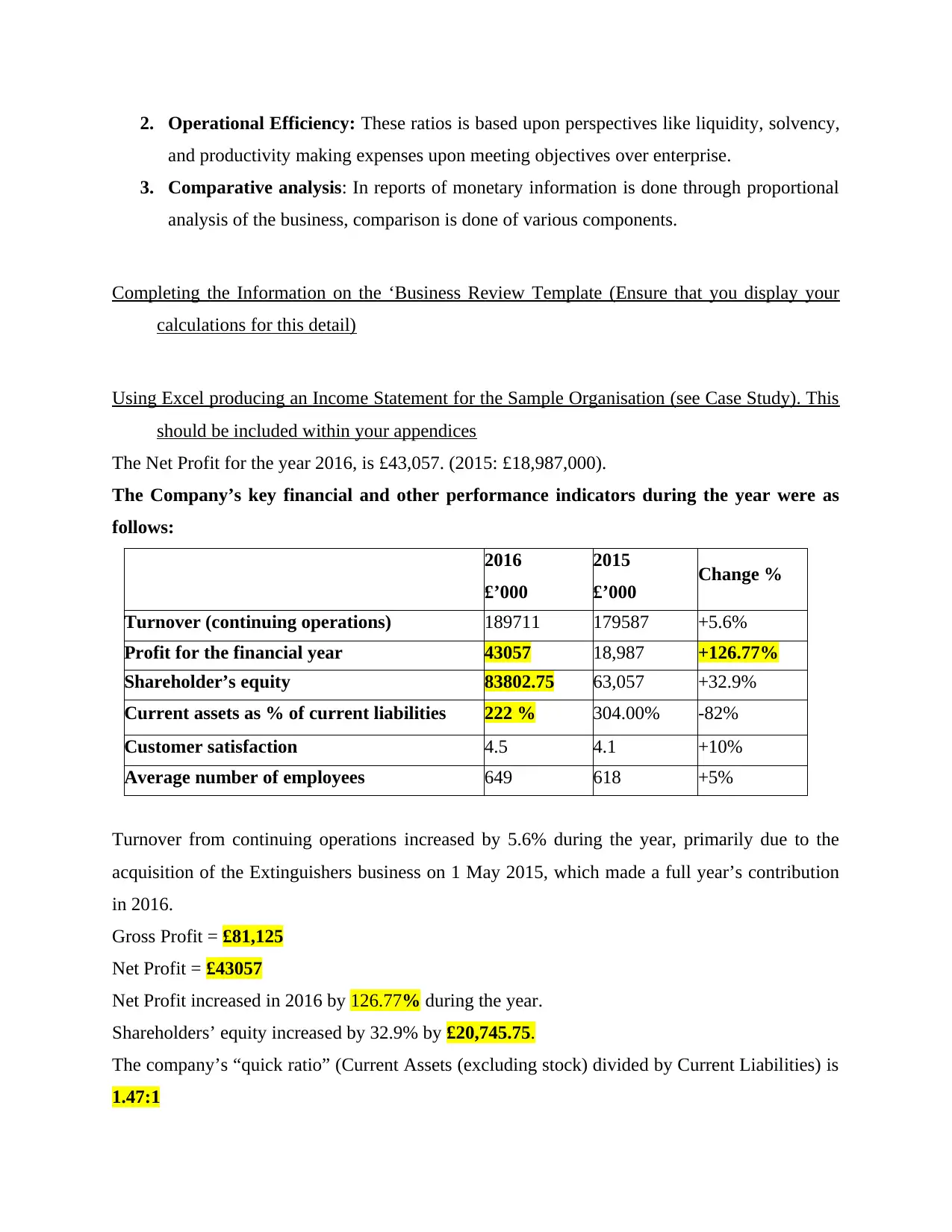
2. Operational Efficiency: These ratios is based upon perspectives like liquidity, solvency,
and productivity making expenses upon meeting objectives over enterprise.
3. Comparative analysis: In reports of monetary information is done through proportional
analysis of the business, comparison is done of various components.
Completing the Information on the ‘Business Review Template (Ensure that you display your
calculations for this detail)
Using Excel producing an Income Statement for the Sample Organisation (see Case Study). This
should be included within your appendices
The Net Profit for the year 2016, is £43,057. (2015: £18,987,000).
The Company’s key financial and other performance indicators during the year were as
follows:
2016
£’000
2015
£’000 Change %
Turnover (continuing operations) 189711 179587 +5.6%
Profit for the financial year 43057 18,987 +126.77%
Shareholder’s equity 83802.75 63,057 +32.9%
Current assets as % of current liabilities 222 % 304.00% -82%
Customer satisfaction 4.5 4.1 +10%
Average number of employees 649 618 +5%
Turnover from continuing operations increased by 5.6% during the year, primarily due to the
acquisition of the Extinguishers business on 1 May 2015, which made a full year’s contribution
in 2016.
Gross Profit = £81,125
Net Profit = £43057
Net Profit increased in 2016 by 126.77% during the year.
Shareholders’ equity increased by 32.9% by £20,745.75.
The company’s “quick ratio” (Current Assets (excluding stock) divided by Current Liabilities) is
1.47:1
and productivity making expenses upon meeting objectives over enterprise.
3. Comparative analysis: In reports of monetary information is done through proportional
analysis of the business, comparison is done of various components.
Completing the Information on the ‘Business Review Template (Ensure that you display your
calculations for this detail)
Using Excel producing an Income Statement for the Sample Organisation (see Case Study). This
should be included within your appendices
The Net Profit for the year 2016, is £43,057. (2015: £18,987,000).
The Company’s key financial and other performance indicators during the year were as
follows:
2016
£’000
2015
£’000 Change %
Turnover (continuing operations) 189711 179587 +5.6%
Profit for the financial year 43057 18,987 +126.77%
Shareholder’s equity 83802.75 63,057 +32.9%
Current assets as % of current liabilities 222 % 304.00% -82%
Customer satisfaction 4.5 4.1 +10%
Average number of employees 649 618 +5%
Turnover from continuing operations increased by 5.6% during the year, primarily due to the
acquisition of the Extinguishers business on 1 May 2015, which made a full year’s contribution
in 2016.
Gross Profit = £81,125
Net Profit = £43057
Net Profit increased in 2016 by 126.77% during the year.
Shareholders’ equity increased by 32.9% by £20,745.75.
The company’s “quick ratio” (Current Assets (excluding stock) divided by Current Liabilities) is
1.47:1
⊘ This is a preview!⊘
Do you want full access?
Subscribe today to unlock all pages.

Trusted by 1+ million students worldwide
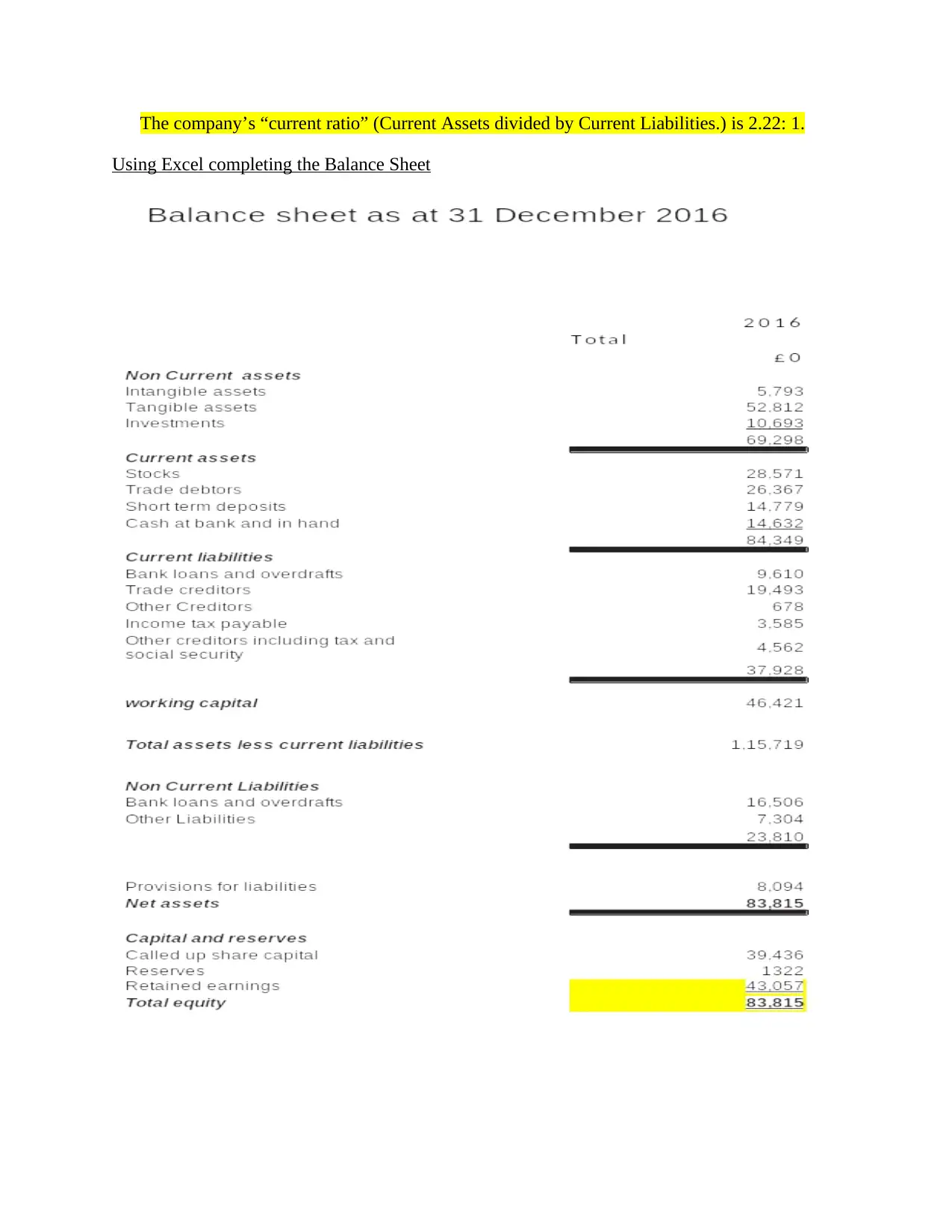
The company’s “current ratio” (Current Assets divided by Current Liabilities.) is 2.22: 1.
Using Excel completing the Balance Sheet
Using Excel completing the Balance Sheet
Paraphrase This Document
Need a fresh take? Get an instant paraphrase of this document with our AI Paraphraser
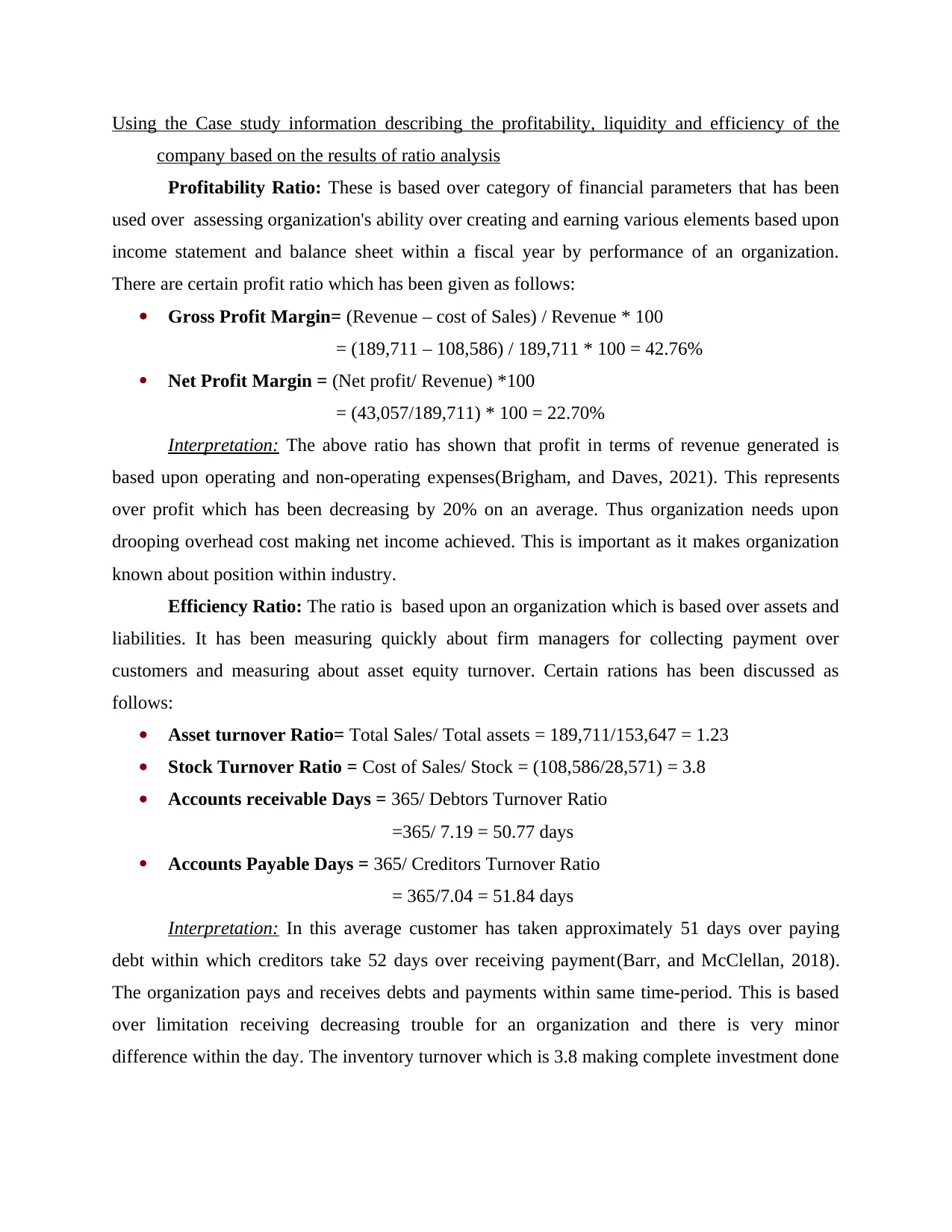
Using the Case study information describing the profitability, liquidity and efficiency of the
company based on the results of ratio analysis
Profitability Ratio: These is based over category of financial parameters that has been
used over assessing organization's ability over creating and earning various elements based upon
income statement and balance sheet within a fiscal year by performance of an organization.
There are certain profit ratio which has been given as follows:
Gross Profit Margin= (Revenue – cost of Sales) / Revenue * 100
= (189,711 – 108,586) / 189,711 * 100 = 42.76%
Net Profit Margin = (Net profit/ Revenue) *100
= (43,057/189,711) * 100 = 22.70%
Interpretation: The above ratio has shown that profit in terms of revenue generated is
based upon operating and non-operating expenses(Brigham, and Daves, 2021). This represents
over profit which has been decreasing by 20% on an average. Thus organization needs upon
drooping overhead cost making net income achieved. This is important as it makes organization
known about position within industry.
Efficiency Ratio: The ratio is based upon an organization which is based over assets and
liabilities. It has been measuring quickly about firm managers for collecting payment over
customers and measuring about asset equity turnover. Certain rations has been discussed as
follows:
Asset turnover Ratio= Total Sales/ Total assets = 189,711/153,647 = 1.23
Stock Turnover Ratio = Cost of Sales/ Stock = (108,586/28,571) = 3.8
Accounts receivable Days = 365/ Debtors Turnover Ratio
=365/ 7.19 = 50.77 days
Accounts Payable Days = 365/ Creditors Turnover Ratio
= 365/7.04 = 51.84 days
Interpretation: In this average customer has taken approximately 51 days over paying
debt within which creditors take 52 days over receiving payment(Barr, and McClellan, 2018).
The organization pays and receives debts and payments within same time-period. This is based
over limitation receiving decreasing trouble for an organization and there is very minor
difference within the day. The inventory turnover which is 3.8 making complete investment done
company based on the results of ratio analysis
Profitability Ratio: These is based over category of financial parameters that has been
used over assessing organization's ability over creating and earning various elements based upon
income statement and balance sheet within a fiscal year by performance of an organization.
There are certain profit ratio which has been given as follows:
Gross Profit Margin= (Revenue – cost of Sales) / Revenue * 100
= (189,711 – 108,586) / 189,711 * 100 = 42.76%
Net Profit Margin = (Net profit/ Revenue) *100
= (43,057/189,711) * 100 = 22.70%
Interpretation: The above ratio has shown that profit in terms of revenue generated is
based upon operating and non-operating expenses(Brigham, and Daves, 2021). This represents
over profit which has been decreasing by 20% on an average. Thus organization needs upon
drooping overhead cost making net income achieved. This is important as it makes organization
known about position within industry.
Efficiency Ratio: The ratio is based upon an organization which is based over assets and
liabilities. It has been measuring quickly about firm managers for collecting payment over
customers and measuring about asset equity turnover. Certain rations has been discussed as
follows:
Asset turnover Ratio= Total Sales/ Total assets = 189,711/153,647 = 1.23
Stock Turnover Ratio = Cost of Sales/ Stock = (108,586/28,571) = 3.8
Accounts receivable Days = 365/ Debtors Turnover Ratio
=365/ 7.19 = 50.77 days
Accounts Payable Days = 365/ Creditors Turnover Ratio
= 365/7.04 = 51.84 days
Interpretation: In this average customer has taken approximately 51 days over paying
debt within which creditors take 52 days over receiving payment(Barr, and McClellan, 2018).
The organization pays and receives debts and payments within same time-period. This is based
over limitation receiving decreasing trouble for an organization and there is very minor
difference within the day. The inventory turnover which is 3.8 making complete investment done
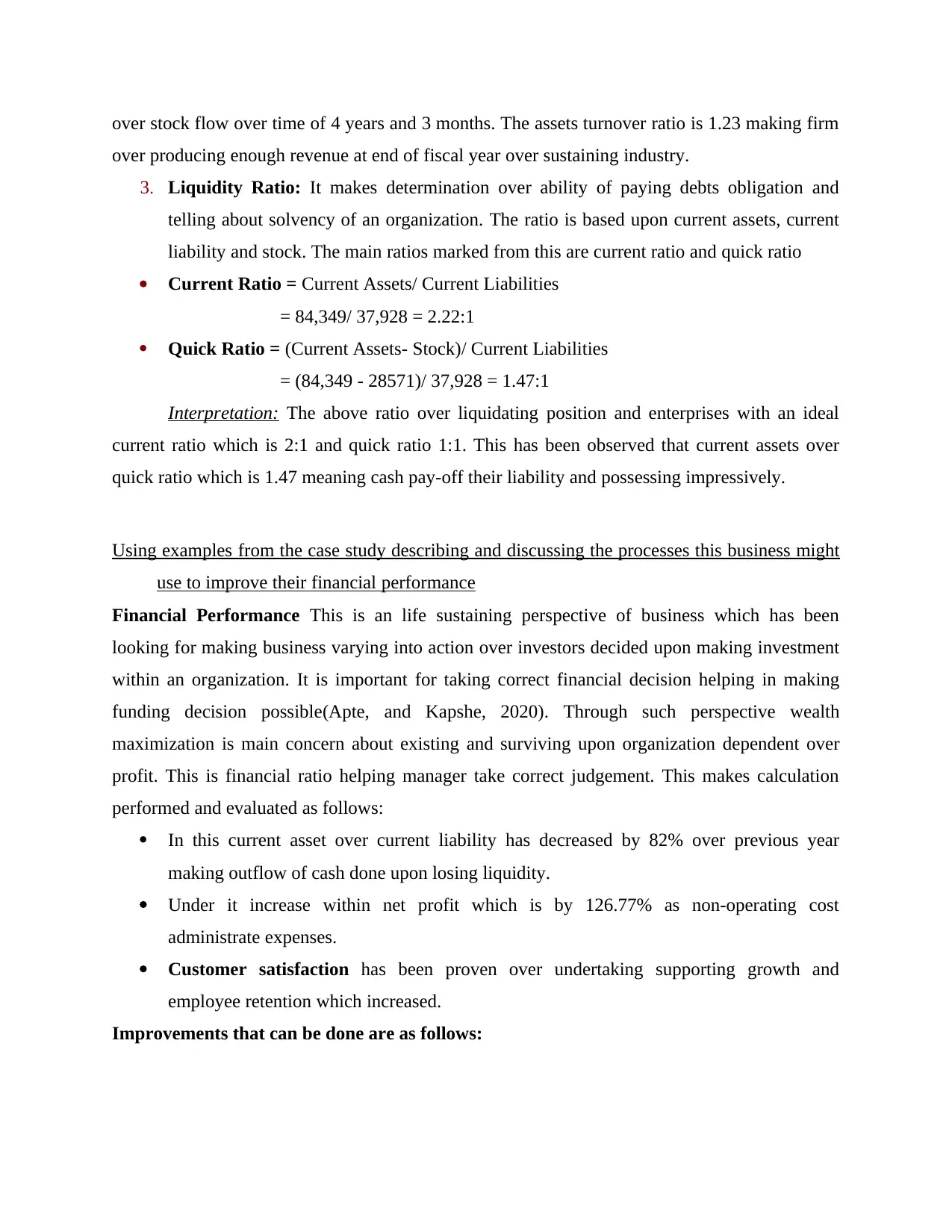
over stock flow over time of 4 years and 3 months. The assets turnover ratio is 1.23 making firm
over producing enough revenue at end of fiscal year over sustaining industry.
3. Liquidity Ratio: It makes determination over ability of paying debts obligation and
telling about solvency of an organization. The ratio is based upon current assets, current
liability and stock. The main ratios marked from this are current ratio and quick ratio
Current Ratio = Current Assets/ Current Liabilities
= 84,349/ 37,928 = 2.22:1
Quick Ratio = (Current Assets- Stock)/ Current Liabilities
= (84,349 - 28571)/ 37,928 = 1.47:1
Interpretation: The above ratio over liquidating position and enterprises with an ideal
current ratio which is 2:1 and quick ratio 1:1. This has been observed that current assets over
quick ratio which is 1.47 meaning cash pay-off their liability and possessing impressively.
Using examples from the case study describing and discussing the processes this business might
use to improve their financial performance
Financial Performance This is an life sustaining perspective of business which has been
looking for making business varying into action over investors decided upon making investment
within an organization. It is important for taking correct financial decision helping in making
funding decision possible(Apte, and Kapshe, 2020). Through such perspective wealth
maximization is main concern about existing and surviving upon organization dependent over
profit. This is financial ratio helping manager take correct judgement. This makes calculation
performed and evaluated as follows:
In this current asset over current liability has decreased by 82% over previous year
making outflow of cash done upon losing liquidity.
Under it increase within net profit which is by 126.77% as non-operating cost
administrate expenses.
Customer satisfaction has been proven over undertaking supporting growth and
employee retention which increased.
Improvements that can be done are as follows:
over producing enough revenue at end of fiscal year over sustaining industry.
3. Liquidity Ratio: It makes determination over ability of paying debts obligation and
telling about solvency of an organization. The ratio is based upon current assets, current
liability and stock. The main ratios marked from this are current ratio and quick ratio
Current Ratio = Current Assets/ Current Liabilities
= 84,349/ 37,928 = 2.22:1
Quick Ratio = (Current Assets- Stock)/ Current Liabilities
= (84,349 - 28571)/ 37,928 = 1.47:1
Interpretation: The above ratio over liquidating position and enterprises with an ideal
current ratio which is 2:1 and quick ratio 1:1. This has been observed that current assets over
quick ratio which is 1.47 meaning cash pay-off their liability and possessing impressively.
Using examples from the case study describing and discussing the processes this business might
use to improve their financial performance
Financial Performance This is an life sustaining perspective of business which has been
looking for making business varying into action over investors decided upon making investment
within an organization. It is important for taking correct financial decision helping in making
funding decision possible(Apte, and Kapshe, 2020). Through such perspective wealth
maximization is main concern about existing and surviving upon organization dependent over
profit. This is financial ratio helping manager take correct judgement. This makes calculation
performed and evaluated as follows:
In this current asset over current liability has decreased by 82% over previous year
making outflow of cash done upon losing liquidity.
Under it increase within net profit which is by 126.77% as non-operating cost
administrate expenses.
Customer satisfaction has been proven over undertaking supporting growth and
employee retention which increased.
Improvements that can be done are as follows:
⊘ This is a preview!⊘
Do you want full access?
Subscribe today to unlock all pages.

Trusted by 1+ million students worldwide
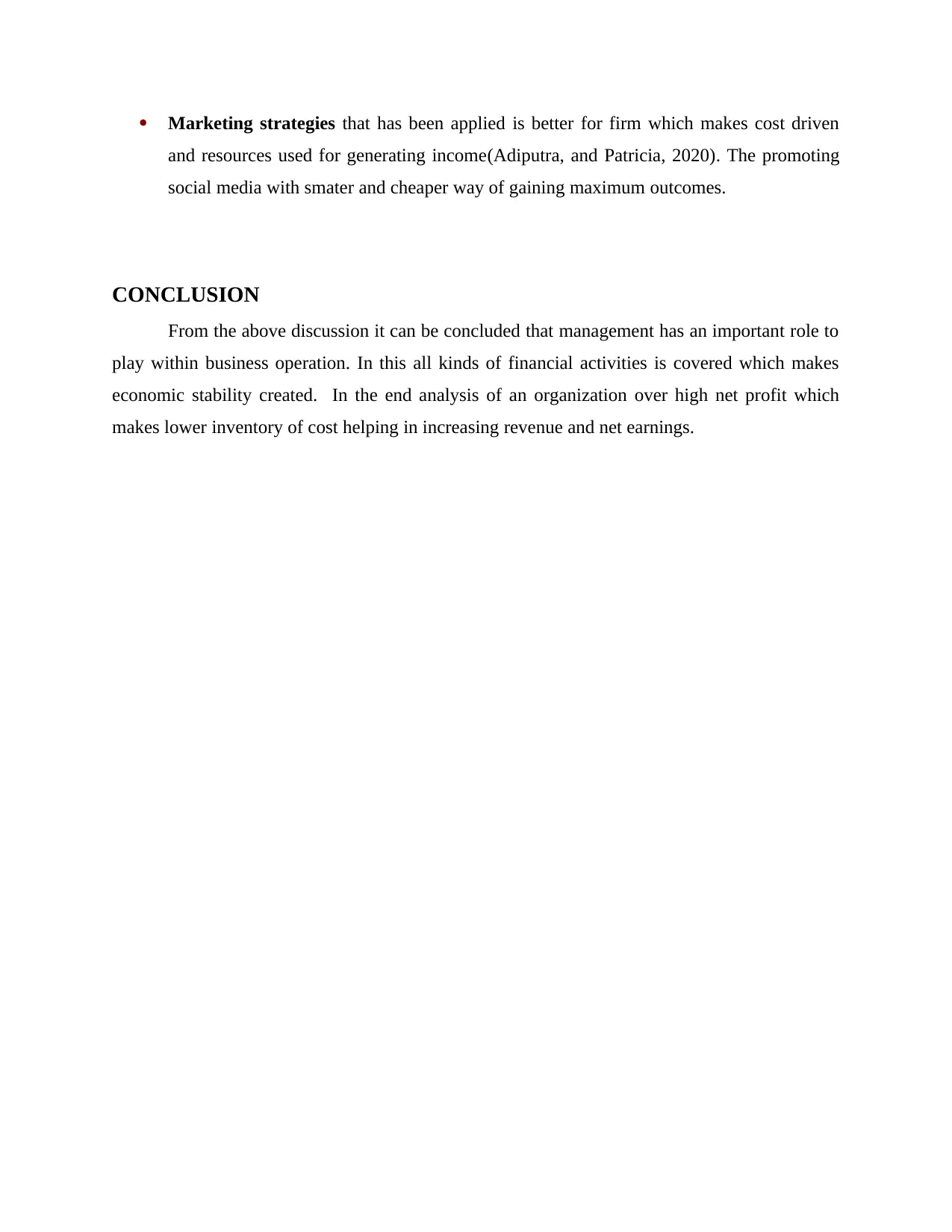
Marketing strategies that has been applied is better for firm which makes cost driven
and resources used for generating income(Adiputra, and Patricia, 2020). The promoting
social media with smater and cheaper way of gaining maximum outcomes.
CONCLUSION
From the above discussion it can be concluded that management has an important role to
play within business operation. In this all kinds of financial activities is covered which makes
economic stability created. In the end analysis of an organization over high net profit which
makes lower inventory of cost helping in increasing revenue and net earnings.
and resources used for generating income(Adiputra, and Patricia, 2020). The promoting
social media with smater and cheaper way of gaining maximum outcomes.
CONCLUSION
From the above discussion it can be concluded that management has an important role to
play within business operation. In this all kinds of financial activities is covered which makes
economic stability created. In the end analysis of an organization over high net profit which
makes lower inventory of cost helping in increasing revenue and net earnings.
Paraphrase This Document
Need a fresh take? Get an instant paraphrase of this document with our AI Paraphraser
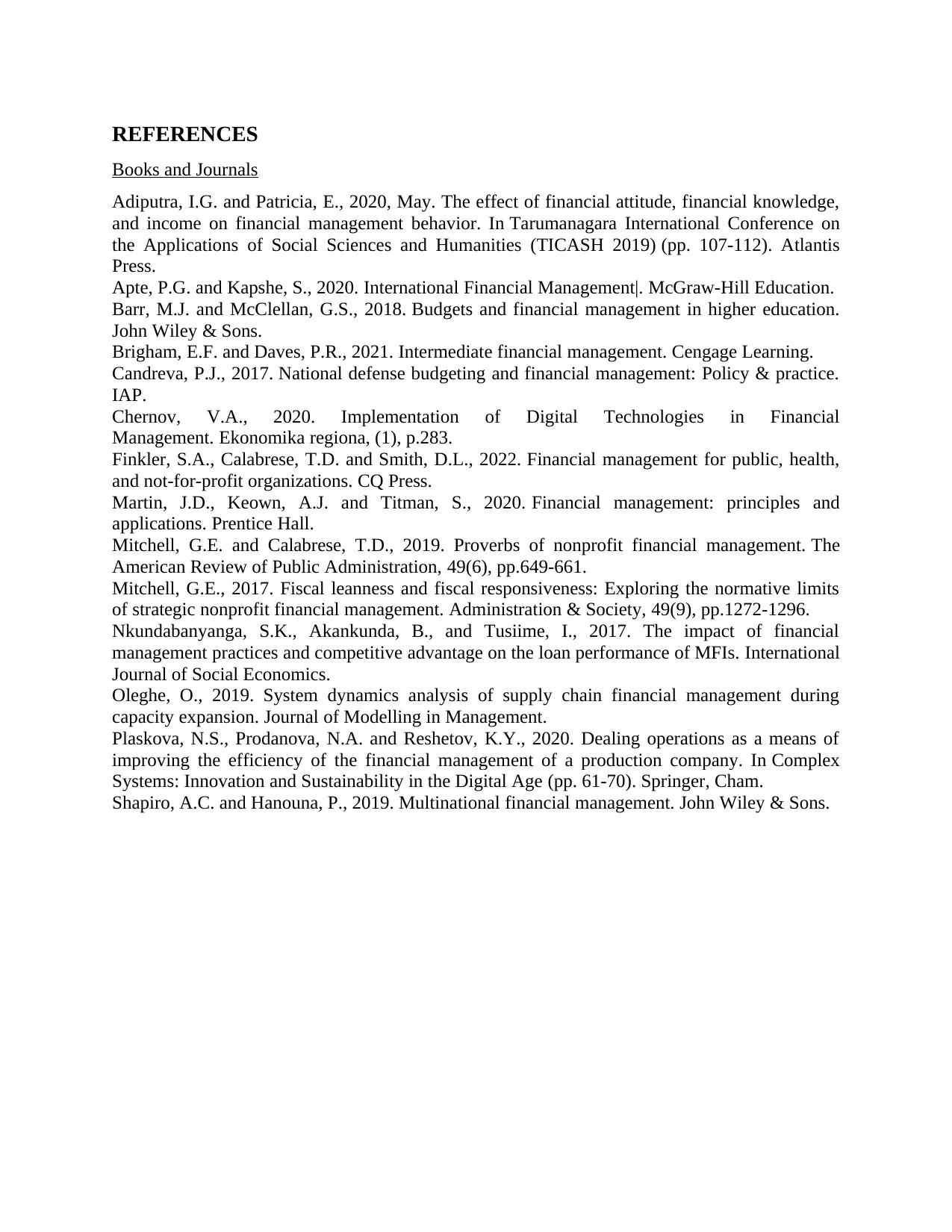
REFERENCES
Books and Journals
Adiputra, I.G. and Patricia, E., 2020, May. The effect of financial attitude, financial knowledge,
and income on financial management behavior. In Tarumanagara International Conference on
the Applications of Social Sciences and Humanities (TICASH 2019) (pp. 107-112). Atlantis
Press.
Apte, P.G. and Kapshe, S., 2020. International Financial Management|. McGraw-Hill Education.
Barr, M.J. and McClellan, G.S., 2018. Budgets and financial management in higher education.
John Wiley & Sons.
Brigham, E.F. and Daves, P.R., 2021. Intermediate financial management. Cengage Learning.
Candreva, P.J., 2017. National defense budgeting and financial management: Policy & practice.
IAP.
Chernov, V.A., 2020. Implementation of Digital Technologies in Financial
Management. Ekonomika regiona, (1), p.283.
Finkler, S.A., Calabrese, T.D. and Smith, D.L., 2022. Financial management for public, health,
and not-for-profit organizations. CQ Press.
Martin, J.D., Keown, A.J. and Titman, S., 2020. Financial management: principles and
applications. Prentice Hall.
Mitchell, G.E. and Calabrese, T.D., 2019. Proverbs of nonprofit financial management. The
American Review of Public Administration, 49(6), pp.649-661.
Mitchell, G.E., 2017. Fiscal leanness and fiscal responsiveness: Exploring the normative limits
of strategic nonprofit financial management. Administration & Society, 49(9), pp.1272-1296.
Nkundabanyanga, S.K., Akankunda, B., and Tusiime, I., 2017. The impact of financial
management practices and competitive advantage on the loan performance of MFIs. International
Journal of Social Economics.
Oleghe, O., 2019. System dynamics analysis of supply chain financial management during
capacity expansion. Journal of Modelling in Management.
Plaskova, N.S., Prodanova, N.A. and Reshetov, K.Y., 2020. Dealing operations as a means of
improving the efficiency of the financial management of a production company. In Complex
Systems: Innovation and Sustainability in the Digital Age (pp. 61-70). Springer, Cham.
Shapiro, A.C. and Hanouna, P., 2019. Multinational financial management. John Wiley & Sons.
Books and Journals
Adiputra, I.G. and Patricia, E., 2020, May. The effect of financial attitude, financial knowledge,
and income on financial management behavior. In Tarumanagara International Conference on
the Applications of Social Sciences and Humanities (TICASH 2019) (pp. 107-112). Atlantis
Press.
Apte, P.G. and Kapshe, S., 2020. International Financial Management|. McGraw-Hill Education.
Barr, M.J. and McClellan, G.S., 2018. Budgets and financial management in higher education.
John Wiley & Sons.
Brigham, E.F. and Daves, P.R., 2021. Intermediate financial management. Cengage Learning.
Candreva, P.J., 2017. National defense budgeting and financial management: Policy & practice.
IAP.
Chernov, V.A., 2020. Implementation of Digital Technologies in Financial
Management. Ekonomika regiona, (1), p.283.
Finkler, S.A., Calabrese, T.D. and Smith, D.L., 2022. Financial management for public, health,
and not-for-profit organizations. CQ Press.
Martin, J.D., Keown, A.J. and Titman, S., 2020. Financial management: principles and
applications. Prentice Hall.
Mitchell, G.E. and Calabrese, T.D., 2019. Proverbs of nonprofit financial management. The
American Review of Public Administration, 49(6), pp.649-661.
Mitchell, G.E., 2017. Fiscal leanness and fiscal responsiveness: Exploring the normative limits
of strategic nonprofit financial management. Administration & Society, 49(9), pp.1272-1296.
Nkundabanyanga, S.K., Akankunda, B., and Tusiime, I., 2017. The impact of financial
management practices and competitive advantage on the loan performance of MFIs. International
Journal of Social Economics.
Oleghe, O., 2019. System dynamics analysis of supply chain financial management during
capacity expansion. Journal of Modelling in Management.
Plaskova, N.S., Prodanova, N.A. and Reshetov, K.Y., 2020. Dealing operations as a means of
improving the efficiency of the financial management of a production company. In Complex
Systems: Innovation and Sustainability in the Digital Age (pp. 61-70). Springer, Cham.
Shapiro, A.C. and Hanouna, P., 2019. Multinational financial management. John Wiley & Sons.

⊘ This is a preview!⊘
Do you want full access?
Subscribe today to unlock all pages.

Trusted by 1+ million students worldwide
1 out of 13
Related Documents
Your All-in-One AI-Powered Toolkit for Academic Success.
+13062052269
info@desklib.com
Available 24*7 on WhatsApp / Email
![[object Object]](/_next/static/media/star-bottom.7253800d.svg)
Unlock your academic potential
Copyright © 2020–2025 A2Z Services. All Rights Reserved. Developed and managed by ZUCOL.


